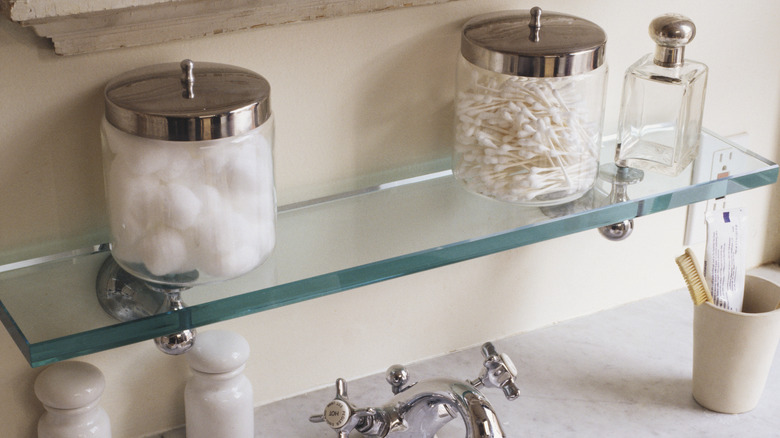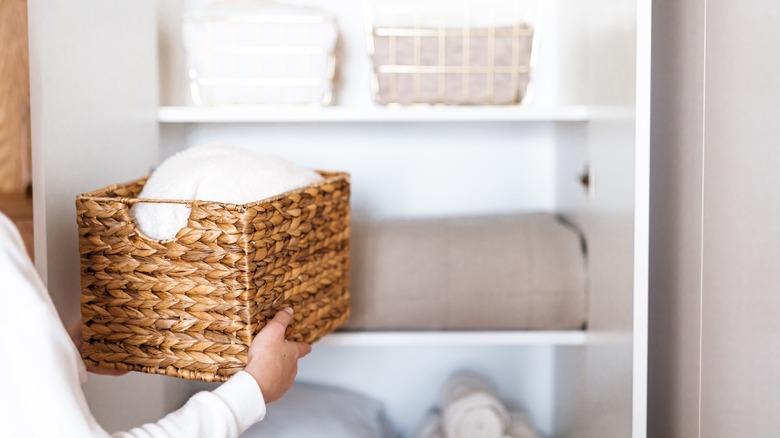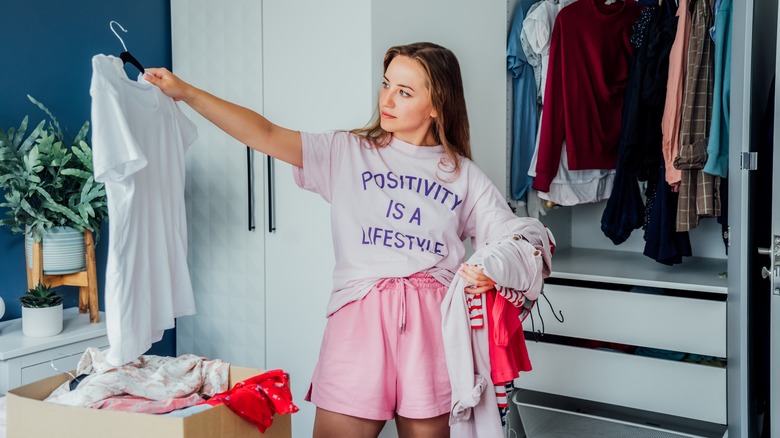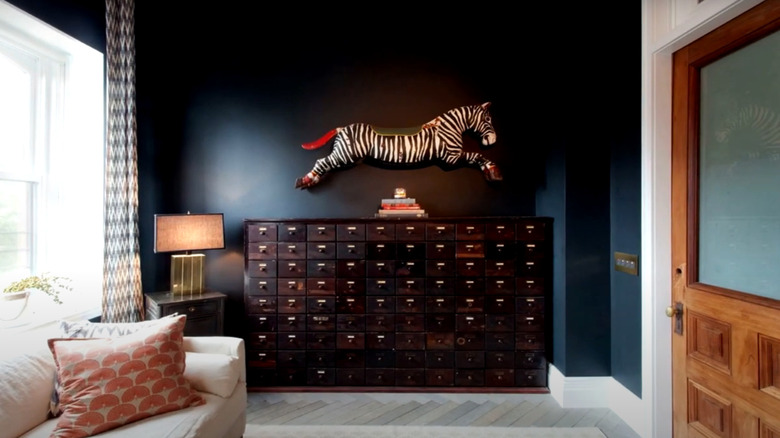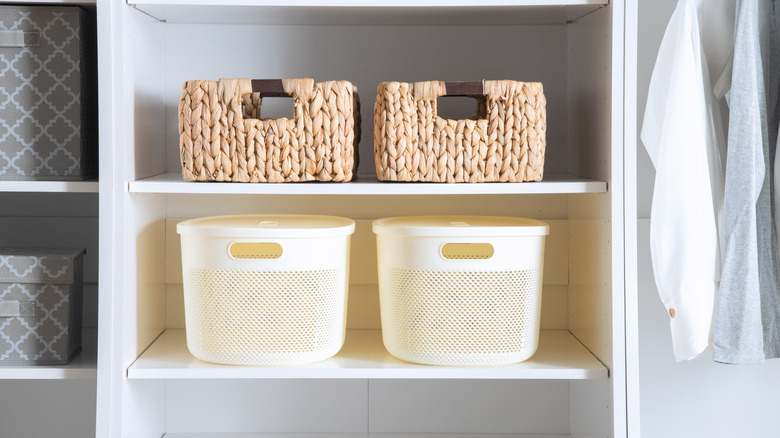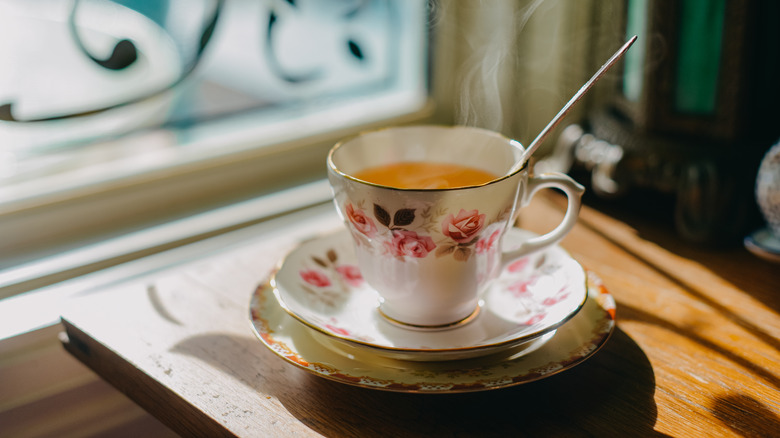Smart Organization Tips That Even HGTV Stars Swear By
We may receive a commission on purchases made from links.
Organizing is a never-ending process. Even after meticulously sorting through every corner of your home, decluttering overstuffed closets, and implementing smart storage solutions, things can quickly slip back into chaos. That's because life either gets busy or new items inevitably find their way in, constantly challenging you to fine-tune your organization strategies. If you're currently re-ordering your home, you might be in the market to find smart organization tips that can help you better corral your new messes. Well, there is no better place to look for guidance than HGTV, which is brimming with home remodeling stars, designers, and organization experts who can help you curb your disorder and make your space look aesthetic while doing it.
Whether you need help learning how to declutter, implement new organization systems, or need product recommendations to reduce visual clutter, these stars have you covered. From Bobby Berk sharing an easy method that gamifies cleaning to Emily Henderson suggesting storing items in baskets so you don't have to fold or sort them, these tips can help put your house back into sorts. Some are even unconventional, such as Joanna Gaines' idea of leaving more items visible to encourage tidiness. These stars have made it their life's work to round up "stuff" and find aesthetic homes for it, and they can help you do the same. Here are organizing tips they swear by.
Joanna Gaines declutters by displaying things out in the open
It might seem counter-intuitive to organize your space by keeping things out in the open. After all, doesn't the room look neater if your essentials are tucked away into bins and baskets behind closed doors? While that's true, displaying things can also force you to keep them minimal and tidy. According to Joanna Gaines, it also helps make the room look more aesthetic since you will be forced to corral them into decorative containers or trays. "By having things out in the open and in cute containers, you actually reduce the clutter," she told The Delite. Think of it this way: If you have a tray to display your skincare in the bathroom, you won't want to over-buy moisturizers and creams since the counter will look cluttered with 15 different bottles. Instead, you will only want to display a select few. And the fewer items we own, the easier it is to keep everything organized.
To implement this in your own home, take a page out of Gaines' book, literally. In her book "Homebody", Gaines wrote, "The fun thing about being creative with the way you contain things is that things that typically wouldn't be cute, like cotton balls and Q-Tips, you can make it cute by getting cute little glass jars and putting them in a basket." When sourcing these containers, match them to your room's theme. For instance, if you have a wabi-sabi organic bedroom, use a travertine tray to capture your wallet and ear pods, like the Travertine Rectangular Tray from Industry West for $175. Or if you have a farmhouse inspired bathroom, consider using crystal containers for cotton balls, like this Gray Speckled Clay container from Mad About Pottery, for $51.
Nate Berkus says to develop a system and stick with it
The fastest way to organize your space is to choose an organizing system. Whether that's storing your shoes in clear shoeboxes or stashing your everyday t-shirts into mesh pullout baskets, implementing a system will help you put away things into designated homes rather than throwing them on the floor or a catch-all chair. "My top tip for keeping my home and any home organized? You have to develop a system and stick with it," Nate Berkus shared on Instagram. If you take the time to choose storage products and carefully designate where each item goes, then you will be less likely to leave those items out and messy.
However, restructuring your home can be a daunting task, especially if you have to implement a system into every closet, cabinet, and drawer. But according to Berkus, this doesn't have to be the case. "I don't think you can organize the entire house, it's too overwhelming in one shot," he shared on Instagram. "But you can pick even a drawer out of the cabinet or a linen closet and just make that your goal for the weekend." It's easy organization advice for those who keep putting it off. Breaking it up into bite-size pieces means less labor and less time commitment, making it easier to start.
Bobby Berk uses the 10-10-100 decluttering method
Sometimes, to get properly organized, you need to declutter. Having less to keep track of makes staying tidy easier, but sometimes it can be hard to figure out what to get rid of. However, Bobby Berk has some tips on that. He personally embraces the 10-10-100 method, which promotes quick and easy decluttering in 10 minutes. It tasks you with taking 10 minutes to declutter 10 things from a certain area. This can be as expansive as your whole bedroom or as minuscule as that one junk drawer in your desk. Then you want to do this for 10 days straight, until you remove 100 items. However, they don't necessarily need to be things like trinkets or decor pieces. "These could be anything from empty containers to old paperwork to clothing items," Berk explains on his website. The beauty of this method is that it's pretty fun and rewarding. "Part of what makes this method effective is that you can treat it like a challenge — and physically see tangible results as you pile up 100 items," he explains. By gamifying the task, you're more likely to actually do it.
To pull this off in your own home, try setting a timer on your phone to make the countdown more official. That way, if you don't feel like cleaning, you can tell yourself that it will only take 10 minutes and then you can stop. Most likely, once you begin, you'll probably want to keep on going and declutter a bigger portion of the room.
Genevieve Gorder recommends moving your junk drawer into an apothecary dresser
A junk drawer feels like mayhem because it captures a random pile of stuff. There is no rhyme or reason to it. Phone chargers are stuffed next to leftover paperclips which are stored next to loose batteries. If you find yourself constantly creating a junk drawer despite your best efforts, it might just be that you like to have these types of items on hand. If that's the case, Genevieve Gorder recommends moving the mess into something more stylish and segmented, like an apothecary cabinet. "The junk drawer — we all have this space in our house. So what I suggest is finding an apothecary of sorts," she shares with The Design Network. "In each of these 100 drawers, I labeled all my weird stuff." She puts things like twine, strings, tapes, and "extension cords and old tech cords that you don't really want to throw away" inside the unit, helping to divide the items.
To pull this off at home, first take everything out of your junk drawer and section the items into piles you would store in each separate drawer. This will give you an idea of how big of a cabinet you'll need. For instance, if you have 10 piles, you can get away with a small cabinet, but if you have 30 items you'd like to segment, you'll need a bigger statement piece. You can get a mini, 10-drawer apothecary cabinet from Amazon for as little as $65.99. However, a bigger, 64-drawer cabinet will set you back $329.99 on Amazon. While it's a larger investment, it will help you get organized once and for all, especially if you pick a chest that allows you to add labels to the drawer fronts.
Emily Henderson recommends simplifying things by using baskets
You might have had ambitions to perfectly fold all of your clothes in drawers and neatly hang your staples on all kinds of specialty hangers. But if you don't have much time in the day or are a naturally messy person, you'll soon find that this method is too high maintenance for your lifestyle. The end result will be a messy closet or entryway that never seems to look nice, even though you have a ton of organizers to help you. To avoid this pitfall, HGTV's Emily Henderson recommends using baskets to corral your items instead. If you have a hard time hanging things up or folding them, baskets are a great shortcut to tidiness. "A lot of what I see online sometimes requires too many steps, like putting your coats on hangers instead of hooks. My kids won't put things on hangers. They also won't put their shoes in those cute little drawers on a day-to-day basis. For us it's 'Here's the sports basket' and 'Here's the shoe basket,' and that's it," she shared with Domino. "It's very simple and actually manageable."
To implement her advice in your own home, see which areas you have the most trouble keeping tidy. Do you avoid folding your freshly laundered leisurewear because it takes forever? Or does your entryway have a whole pile of sandals and flip flops by the front door, even though there is a shoe cabinet right next to it? If so, set up large enough baskets to capture those pieces and use them as your new system.
Jill Harris recommends asking yourself if you use the item anymore
When it comes to decluttering, it can be immensely difficult to throw away or donate items. Maybe you regret spending money on it and feel less guilty about the purchase if you keep it. Or perhaps you're not entirely sure how you feel about that item, and are holding onto it just in case your tastes change. Whatever the reason, it leaves our houses cluttered and messy, packed with stuff we don't need. To help you finally put these items into a donation box, Jill Harris recommends asking yourself if you use the item anymore. When she hired a professional organizer to reconfigure her home, Harris learned of an easy way to make her decision on whether to keep or toss something. "With each item we pull out of its hiding place, Megan would prompt me to ask myself, 'do I really use this?' This is a GREAT question to ask yourself. You would be surprised how many things we hold onto that we don't even use," she shared on her website.
Realistically, you should only be keeping things in your home that you regularly utilize. Otherwise, you're bending yourself into a pretzel trying to find enough storage room for items that serve no purpose to you. Why spend hundreds of dollars on organizers and risers just to make enough room for $20 jeans you hate wearing or cracked traveler mugs you don't ever reach for? So the next time you declutter, take every item out of storage in that particular room and confirm if you still use it or not. If not, it's time to let it go.
Cassandra Aarssen declutters closets by asking if you'd buy the item again
Another way to help declutter your closet is to ask yourself if you would repurchase that item if you had the chance. This question is particularly useful when you're struggling with the "Do I still use this?" dilemma. If you don't use a particular item but are worried you might want to use it again in the near future or will regret tossing it, ask yourself if it would catch your eye if you had to put money down for it. This approach is part of organizer Cassandra Aarssen's three-step process featured on HGTV's "Hot Mess House," where she assists families in decluttering their homes to make their lives more functional. "'If I didn't own this, would I buy it again?' If the answer is no, you don't need it in your home," she told HGTV.
By envisioning a scenario where you would have to spend your hard-earned cash, you can more clearly determine if you genuinely like it or if you're holding onto it out of guilt, fear, or sentimentality. If you decide "no," you know it's just clutter taking up space. This should hopefully make it easier for you to part ways with it.
Bobby Berk recommends giving new items an immediate home
If you're great at putting away all of your existing items into their designated homes, but fall apart when you bring something new into the house, then it's time to take Bobby Berk's sage advice: Find a home for the new item as you bring it in. "Lots of clutter comes from items piling up as soon as they enter your door. So as soon as something new makes its way home, whether it's a piece of mail or a kids toy, designate an area for it to live," he shares on his website. "Letting things lay around for days or weeks means you're less likely to actually get them organized, so be pro-active."
Mail should have a sorting bin it which it goes, but new items need a game plan immediately after crossing the threshold. For example, if you have new clothes, hang them up or fold them right away; if you've acquired new office supplies, place them in their proper organizers at your desk. If you find that your system doesn't have a place for the new item, don't delay buying the proper organizer. For instance, if you've purchased a pair of boots that don't fit in your shoe cabinet, quickly order a boot rack for the bottom of your closet (like this $23 from Amazon). If you delay, the boots will likely end up on the floor until you eventually buy the rack months later.
Cassandra Aarssen says to either use sentimental pieces or let them go
Everyone has a box or two of sentimental pieces. Whether they're your old stuffies from childhood or your grandmother's china, there are things we hold onto that are full of memories. But what happens if those items take up a good chunk of storage space? According to Cassandra Aarssen, if that's the case, you either need to bring them into rotation or let them go. "If it isn't sentimental to you, you shouldn't be keeping it. I think the hardest thing for people to let go of is when loved ones pass away and they're left with things from their grandmother or great-grandmother, but if they're not using it and loving it, they're not honoring that memory by keeping it in a box in the basement," she told HGTV. "The way to truly honor that person is to let it go to someone who could love and use it." It might be difficult to part ways with it, but it's the best thing to do if it's taking up considerable room.
To implement this tip in your own home, take a look at your sentimental pieces and see if you can weave them into your house. For instance, if you have some old childhood books, add them to a bookcase. If you have your mother's old wedding china, start using it for weekday meals to make them feel more special. Or if you have old clothes from a deceased relative, consider turning them into a quilt or throw pillows. In fact, there are companies that can do that for you, such as MemoryStitch and The Patchwork Bear. If you decide you can't keep all of the items, consider taking a photo of the piece so you can still have a tangible memory of it and donate it.

